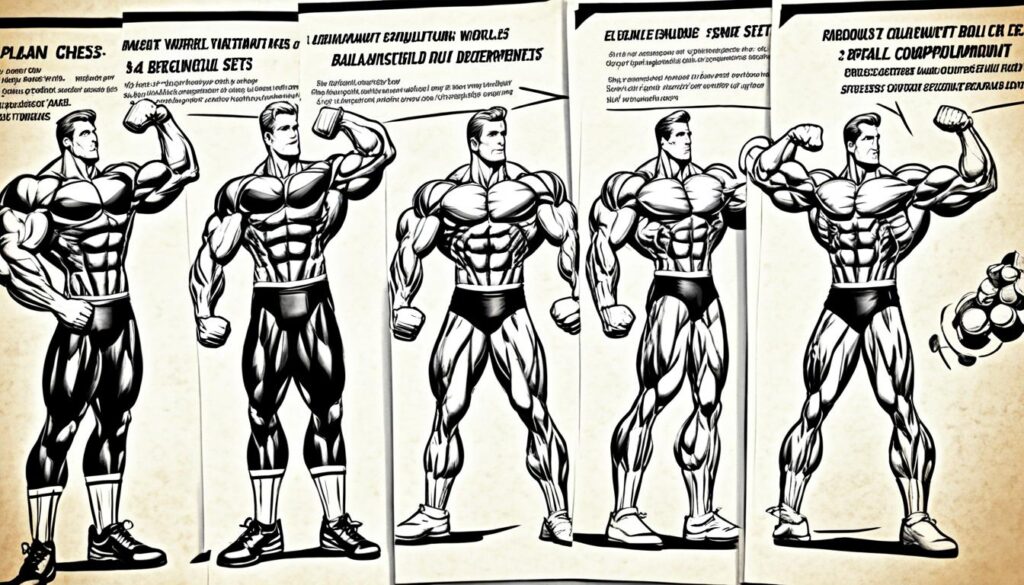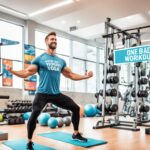Optimizing full body workout for beginners
Welcome to the world of full body workouts! If you’re a beginner looking to kickstart your fitness journey, you’re in the right place. In this section, I’ll provide you with effective strategies to optimize your full body workout routine. By following these tips, you can achieve lean muscle and strength gains while avoiding common pitfalls.
Key Takeaways:
- Optimizing your full body workout routine is crucial for beginners
- By following effective strategies, you can achieve lean muscle and strength gains
- Avoid common pitfalls and maximize your fitness journey
- Stay consistent and listen to your body to see long-term results
- Design a customized workout plan based on your goals
Understanding the basics of a full body workout
Before diving into specific exercises and routines, it’s essential to understand the fundamentals of a full body workout. By targeting your entire body, you can experience numerous benefits, including increased strength, improved cardiovascular fitness, enhanced body composition, and better overall functional movement.
For beginners, dumbbell workouts are an excellent choice due to their accessibility and versatility. Dumbbells are readily available in most gyms and can also be used at home. They allow for a wide range of exercises that engage multiple muscle groups and can be easily scaled to match your current fitness level. Incorporating dumbbells into your full body workout routine will help you build strength and coordination while promoting muscular balance.
Executing exercises with proper form is crucial to maximizing the effectiveness of your full body workout. It not only ensures that you target the intended muscles but also reduces the risk of injuries. It’s recommended to start with lower weights and gradually increase the load as you become more comfortable with the movements.
Remember, consistency is key when it comes to seeing progress as a beginner. Focus on mastering the foundational movements and gradually progress with both weights and repetitions. Don’t be discouraged if you can’t lift heavy weights right away; building strength is a gradual process, and every improvement counts.
Next, let’s delve into the specific exercises and strategies that will help you design an optimized full body workout plan tailored to your goals and fitness level.
The Benefits of Full Body Workouts
Full body workouts offer a holistic approach to fitness by engaging all major muscle groups in a single session. Here are some key benefits:
- Time efficiency: With a full body workout, you can achieve significant results in less time compared to targeting individual muscle groups on separate days.
- Improved muscle balance: By working all muscle groups equally, you reduce the risk of muscle imbalances, which can lead to poor posture and increased injury risk.
- Increased calorie burn: Engaging multiple muscle groups simultaneously boosts your metabolism, helping you burn more calories during and after your workout.
- Enhanced functional strength: Full body exercises mimic real-life movements, improving your overall strength and making everyday tasks easier.
Now that we’ve covered the basics, it’s time to explore the specific exercises that target key muscle groups for a well-rounded full body workout.
Targeting key muscle groups for a balanced routine
In order to create a well-rounded full body workout, it is crucial to target all major muscle groups. By incorporating exercises that engage specific areas of the body, such as the glutes, core, upper body, and lower body, you can achieve balanced muscle development and enhance overall performance.
Engaging the Glutes with Hip Thrusts
One key muscle group to focus on is the glutes. The glutes are essential for stabilizing the hips and promoting proper alignment during various movements. To specifically target and strengthen your glutes, incorporating hip thrusts into your workout routine is highly effective.
Hip thrusts involve lying on your back with your knees bent, feet flat on the ground, and a weight or barbell positioned across your hips. From this starting position, you lift your hips off the ground by engaging your glutes and driving through your heels. Focus on squeezing your glutes at the top of the movement before slowly lowering your hips back down.
Other Key Muscle Groups: Core, Upper Body, and Lower Body
While the glutes are an important focus, it is equally important to target other key muscle groups for a well-rounded routine. The core, upper body, and lower body all play significant roles in overall strength and functional movements.
- Core: Incorporate exercises such as planks, Russian twists, and bicycle crunches to strengthen your core muscles, which provide stability and support for your spine.
- Upper Body: Include exercises like push-ups, pull-ups, and shoulder presses to target your chest, back, shoulders, and arms.
- Lower Body: Incorporate exercises like squats, lunges, and deadlifts to engage your quadriceps, hamstrings, calves, and glutes.
Improving Grip Strength
In addition to targeting specific muscle groups, it is important to pay attention to grip strength while performing exercises. Grip strength is often overlooked but is crucial for safely and effectively lifting weights and performing various movements.
To enhance grip strength, incorporate exercises such as farmer’s walks, deadlift holds, and forearm curls into your workouts. These exercises not only strengthen the muscles in your hands and forearms but also improve overall grip stability and control.
Key Takeaways
When designing your full body workout routine, remember to target all major muscle groups, including the glutes, core, upper body, and lower body. Incorporate exercises such as hip thrusts to engage and strengthen the glutes, as well as various exercises for the core, upper body, and lower body. Additionally, don’t forget to include grip-strengthening exercises to enhance overall performance.
Designing your own full body workout plan
Now that you have a good understanding of the fundamentals and key muscle groups, it’s time to design your own full body workout plan. As a beginner, it’s crucial to create a routine that caters to your fitness goals, whether it’s building lean muscle or gaining strength. By following a well-structured plan, you can optimize your workouts and maximize your results.
Step 1: Set your goals
Before you start designing your workout plan, take some time to define your goals. Are you looking to build lean muscle mass, increase overall strength, or improve your endurance? Having a clear objective will give your workouts direction and purpose.
Step 2: Choose the right exercises
When selecting exercises for your full body workout plan, it’s important to include compound movements that target multiple muscle groups. This will help you build functional strength and promote overall muscle development. Some effective exercises for beginners include squats, deadlifts, lunges, push-ups, and rows.
Step 3: Plan your workout frequency
As a beginner, it’s recommended to start with two to three full body workouts per week. This will allow your muscles to recover and adapt to the new stimulus. As you progress and become more comfortable with your routine, you can gradually increase the frequency and intensity of your workouts.
Step 4: Establish a progressive overload
In order to continue making progress, it’s important to challenge your body by gradually increasing the load or intensity of your exercises. This can be done by adding more weight, increasing the number of sets and repetitions, or decreasing the rest time between sets. Aim to progressively overload your muscles to stimulate growth and strength gains.
Step 5: Listen to your body
While it’s important to have a structured plan, it’s equally important to listen to your body and adjust accordingly. Pay attention to how your muscles feel during and after each workout. If you experience excessive fatigue, soreness, or discomfort, it may be a sign to modify your routine or take a day off to allow for proper recovery.
Step 6: Adapt and evolve
As you gain experience and become more comfortable with your full body workouts, don’t be afraid to experiment with different exercises, rep ranges, and training techniques. Your workout plan should be flexible and adaptable to your changing fitness level and goals. Continuously challenging yourself will keep your workouts exciting and prevent plateaus.
Remember, designing your own full body workout plan requires careful consideration of your goals, exercise selection, frequency, progressive overload, and self-awareness. By following these steps and staying consistent, you can achieve significant improvements in lean muscle mass and strength gains.

Conclusion
In conclusion, achieving balanced muscle development and strength gains as a beginner requires a well-optimized full body workout. By understanding the basics of a full body workout and targeting key muscle groups, you can lay a solid foundation for your fitness journey. Designing a personalized workout plan based on your goals will help you progress and see long-term results.
It’s important to start at your own pace and listen to your body. Push yourself but also know your limits to avoid injury. Consistency is key in seeing improvements, so make sure to stick to your workout routine. Remember, the journey to a stronger and fitter body takes time and dedication, but the results will be worth it.
As you continue your full body workout, take note of proper form and technique to maximize effectiveness and minimize the risk of injury. Whether you choose to use dumbbells or other equipment, always prioritize safety and seek guidance from a professional trainer if needed.
Embrace the process and celebrate small milestones along the way. With commitment and perseverance, you can take your fitness to new heights and enjoy the benefits of a stronger, healthier body. So go ahead, begin your full body workout journey today!
FAQ
What are the benefits of a full body workout for beginners?
A full body workout targets all major muscle groups, allowing beginners to develop strength and build lean muscle throughout their entire body. It also improves overall fitness and helps to prevent muscle imbalances.
Can I do full body workouts with just dumbbells?
Absolutely! Dumbbell workouts are a versatile option for beginners. They can be used to target various muscle groups and allow for a wide range of exercises. Plus, dumbbells are affordable and can be easily incorporated into your home workout routine.
How do I perform hip thrusts to engage my glutes?
To perform hip thrusts, start by sitting on the floor with your upper back resting against a bench or step. Place a dumbbell on your hips and keep your feet flat on the ground. Press through your heels and lift your hips upward, squeezing your glutes at the top. Lower your hips back down and repeat for the desired number of repetitions.
What can I do to improve my grip strength?
To improve grip strength, try incorporating exercises like farmer’s walks, deadlifts, and bent-over rows into your routine. You can also use grip strengtheners or perform specific grip exercises, such as finger curls and plate pinches.
How do I design a full body workout plan for beginners?
When designing a full body workout plan, consider including compound exercises that target multiple muscle groups, such as squats, lunges, push-ups, and overhead presses. Start with lighter weights and gradually increase the intensity as you progress. It’s also important to rest and recover between workouts to allow your muscles to heal and grow.
